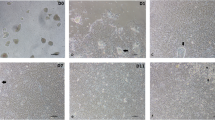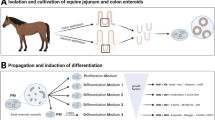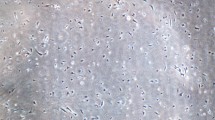Abstract
Many mechanisms involved in the pathogenesis of chronic enteropathies or host–pathogen interactions in canine intestine have not been elucidated so far. Next to the clinical and in vivo research tools, an in vitro model of canine intestinal cell culture would be very helpful for studies at the cellular level. Therefore, the purpose of this study was to establish and characterize a primary canine duodenal epithelial cell culture. Neonatal duodenum was disrupted with trypsin-ethylenediaminetetraacetic acid (EDTA) and the mucosa scraped off and digested with collagenase and dispase. After centrifugation on a 2% sorbitol gradient, the cells were incubated at 37° C in OptiMEM supplemented with Primocin, epidermal growth factor, insulin, hydrocortisone, and 10% fetal calf serum (FCS). After 24 h, the FCS concentration was reduced to 2.5%, and the temperature decreased to 33° C. With this method, the cultures were growing to confluent monolayers within 5–6 d and remained viable for an average of 2 wk. Their epithelial nature was confirmed by electron microscopy and immunofluorescence staining using antibodies directed against specific cytokeratins, desmosomes, and tight junctions. The intestinal cells proliferated, as evidenced by immunolabeling with a Ki-67 antibody, and cryptal cell subpopulations could be identified. Furthermore, alkaline phosphatase and sucrase activity were detected.




Similar content being viewed by others
References
Aldhous, M. C.; Shmakov, A. N.; Bode, J., et al. Characterization of conditions for the primary culture of human small intestinal epithelial cells. Clin. Exp. Immunol. 125:32–40.2001.
Allenspach, K.; Gaschen, F. Chronic intestinal diseases in the dog: a review. Schweiz. Arch. Tierheilkd. 145(5):209–219, 221-2.2003.
Calnek, D.; Quaroni, A. Differential localization by in situ hybridization of distinct keratin mRNA species during intestinal epithelial cell development and differentiation. Differentiation 53:95–104.1993.
Duchmann, R. I.; Kaiser, E.; Hermann, W., et al. Tolerance exists towards resident intestinal flora but is broken in active inflammatory bowel disease (IBD). Clin. Exp. Immunol. 102:448–455.1995.
Engelhardt, P.; Wyder, M.; Zurbriggen, A., et al. Canine disempter virus associated proliferation of canine footpad keratinocytes in vitro. Vet. Microbiol. 107:1–12.2005.
Evans, G. S.; Flint, N.; Somers, A. S., et al. The development of a method for the preparation of rat intestinal epithelial cell primary cultures. J. Cell Sci. 101:219–231.1992.
Föllmann, W.; Weber, S.; Birkner, S. Primary cell cultures of bovine colon epithelium: isolation and cell culture of colonocyte. Toxicol. In Vitro 14:435–445.2000.
Fre, S.; Huyghe, M.; Mourikis, P., et al. Notch signals control the fate of immature progenitor cells in the intestine. Nature 435:964–968.2005.
German, A. J.; Hall, E. J.; Day, M. J. Chronic intestinal inflammation and intestinal disease in dogs. J. Vet. Intern. Med. 17:8–20.2003.
Grossmann, J.; Walther, K.; Artinger, M., et al. Progress on isolation and short-term ex-vivo culture of highly purified non-apoptotic human intestinal cells (IEC). Eur. J. Cell. Biol. 82:262–270.2003.
Hauck, A. L.; Swanson, K. S.; Kenis, P. J. A., et al. Twists and turns in the development and maintenance of the mammalian small intestine epithelium. Birth Defects Res C Embryo Today 75:58–71.2005.
Hemphill, A.; Croft, S. L. Electron microscopy in parasitology. In: Rogan, M. ed. Analytical parasitology. Springer Verlag, Heidelberg, Germany; 1997:227–268.
Hershberg, R. M.; Mayer, L. F. Antigen processing and presentation by intestinal epithelial cells—polarity and complexity. Immunol. Today 21:123–128.2000.
Jung, H. C.; Eckmann, L.; Yang, S. K., et al. A distinct array of proinflammatory cytokines is expressed in human colon epithelial cells in response to bacterial invasion. J. Clin. Invest. 95:55–65.1995.
Kaeffer, B. Mammalian intestinal epithelial cells in primary culture: a mini-review. In Vitro Cell Dev. Biol. Anim. 38:123–134.2002.
Kedinger, M.; Duluc, I.; Fritsch, C., et al. Intestinal epithelial–mesenchymal cell interactions. Ann. N Y Acad. Sci. 859:1–17.1998.
Pageot, L. P.; Perreault, N.; Basora, N., et al. Human cell models to study small intestinal functions: recapitulation of the crypt-villus axis. Microsc. Res. Tech. 49:394–406.2000.
Panja, A. A novel method for the establishment of a pure population of nontransformed human intestinal primary epithelial cell (HIPEC) lines in long term culture. Lab. Invest. 80:1473–1475.2000.
Perreault, N.; Beaulieu, J. F. Use of the dissociating enzyme thermolysin to generate viable human normal intestinal epithelial cell cultures. Exp. Cell Res. 224:354–364.1996.
Perreault, N.; Beaulieu, J. F. Primary cultures of fully differentiated and pure human intestinal epithelial cells. Exp. Cell. Res. 245:34–42.1998.
Plotkin, G. R.; Isselbacher, K. J. Secondary disaccharidase deficiency in adult celiac disease (nontropical sprue) and other malabsorption states. New Engl. J. Med. 271:1033–1037.1964.
Quaroni, A.; Hochman, J. Development of intestinal cell culture models for drug transport and metabolism studies. Adv. Drug Deliv. Res. 22:3–52.1996.
Quaroni, A.; Tian, J. Q.; Göke, M., et al. Glucocorticoids have pleiotropic effects on small intestinal crypt cells. Am. J. Physiol. Gastrointest. Liver Physiol. 277:G1027–G1040.1999.
Saiwaki, T.; Kotera, I.; Sasaki, M., et al. In vivo dynamics and kinetics of pKi-67: transition from a mobile to an immobile form at the onset of anaphase. Exp. Cell Res. 308:123–134.2005.
Savkovic, S. D.; Koutsouris, A.; Hecht, G. Activation of NF-kappaB in intestinal epithelial cells by enteropathogenic Escherichia coli. Am. J. Physiol. 273:C1160–C1167.1997.
Stettler, M.; Siles-Lucas, M.; Sarciron, E., et al. Echinococcus multilocularis alkaline phosphatase as a marker for metacestode damage induced by in vitro drug treatment with albendazole sulfoxide and albendazole sulfone. Antimicrob. Agents Chemother. 45:2256–2262.2001.
Swerdlow, M.; Kennedy, D.; Clayton, D., et al. Cultured colonic epithelial cells express pattern recognition receptors. In Proceedings 22nd ACVIM Forum 853.2004.
Weng, X. H.; Beyenbach, K. W.; Quaroni, A. Cultured monolayers of the dog jejunum with the structural and functional properties resembling the normal epithelium. Am. J. Physiol. Gastrointest. Liver Physiol. 288:G705–G717.2005.
Wong, M. H. Regulation of intestinal stem cells. J. Investig. Dermatol. Symp. Proc. 9:224–228.2004.
Acknowledgments
The authors would like to thank Prof. Beyenbach and Prof. Quaroni for providing the monoclonal antibody TS23 specific to the glycosylated form of Notch-1 and Dr. Herring and Prof. Beaulieu for providing the MIM 1/39 antibody, an intestinal crypt cell marker. Furthermore, the authors would like to acknowledge Ursula Luginbühl for sucrase activity measurement, and many thanks are addressed to Eliane Mueller for advice in immunofluorescence staining.
Author information
Authors and Affiliations
Corresponding author
Additional information
Editor: J. Denry Sato
Julia L. Golaz and Nathalie Vonlaufen contributed equally to this work and are joint first authors. Supported in part by the Vetsuisse research foundation, the Foundation Research 3R (project No. 85/03), and the Swiss National Science Foundation (3100A0-112532).
Rights and permissions
About this article
Cite this article
Golaz, J.L., Vonlaufen, N., Hemphill, A. et al. Establishment and characterization of a primary canine duodenal epithelial cell culture. In Vitro Cell.Dev.Biol.-Animal 43, 176–185 (2007). https://doi.org/10.1007/s11626-007-9034-4
Received:
Accepted:
Published:
Issue Date:
DOI: https://doi.org/10.1007/s11626-007-9034-4




